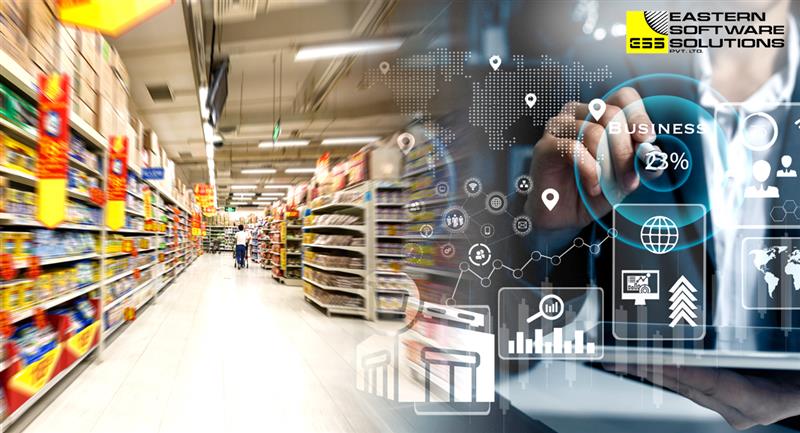Leveraging Retail Analytics For Competitive Advantage In FMCG

In today’s fast-paced retail landscape, staying ahead requires more than just experience and intuition. A data-driven approach is essential for making informed decisions quickly and effectively. This is where retail analytics plays a crucial role, providing actionable insights that drive sales, optimize operations, and enhance customer experiences.
Retail analytics involves analyzing vast datasets to identify shopping patterns, preferences, and market trends. With the rise of digital transactions and consumer data, retailers are leveraging analytics to personalize marketing, optimize inventory, and gain a competitive edge in an increasingly dynamic market. If you’re a retailer who is dealing in FMCG and looking to thrive in this data-driven era, read on to discover how retail analytics can transform your business.
What is Retail Analytics?
Retail analytics is the process of collecting, analyzing, and interpreting data related to sales, customers, and market trends. It helps retailers make informed decisions to improve sales, enhance customer satisfaction, and streamline operations.
Think of it as a powerful magnifying glass that reveals what’s working and what needs improvement in your business. From tracking which products are flying off the shelves to understanding why customers abandon their carts online, retail analytics provides valuable insights that drive success.
Why Retail Analytics Matters?
The retail industry is more competitive than ever. Customers expect personalized shopping experiences, competitive prices, and fast service. To meet these expectations, retailers must go beyond guesswork and base their strategies on solid data.
Here’s why retail analytics is a game-changer:
• Improves Customer Experience: By analyzing shopping behaviors, retailers can offer personalized recommendations and promotions.
• Boosts Sales: Understanding what customers want allows businesses to stock the right products and optimize pricing.
• Enhances Inventory Management: Prevent stockouts and overstock situations by accurately forecasting demand.
• Optimizes Marketing Efforts: Helps businesses create targeted campaigns that convert.
• Increases Profitability: Data-driven decisions minimize losses and maximize profits.
The Role of BI in Retail Analytics for Staying Ahead
1. Understand Customer Behavior
BI helps in getting retail analytics by tracking and analyzing customer preferences, shopping patterns, and purchase history. By knowing your customers better, you can:
• Offer personalized promotions and discounts
• Improve customer service by addressing pain points
• Create loyalty programs that encourage repeat purchases
For example, if analytics show that a customer frequently purchases FMCG products, you can offer them a discount on their preferred brand or suggest complementary items.
2. Optimize Inventory Management
Stocking too much or too little of a product can hurt your business. With BI-driven retail analytics, you can:
• Predict demand and adjust inventory accordingly
• Reduce storage costs by stocking only what sells
• Avoid losing customers due to out-of-stock products
Major retailers use data analytics to manage their inventory efficiently, ensuring they always have the right products at the right time.
3. Personalize Marketing Campaigns
BI helps businesses create targeted marketing strategies that actually work. Instead of sending generic promotions, you can:
• Segment customers based on their interests and purchase history
• Send personalized emails, SMS, or app notifications
• Measure the effectiveness of campaigns and tweak them for better results
4. Enhance In-Store Experience
When you run a physical store improving customer experience is key. BI-driven retail analytics can help by:
• Identifying peak shopping hours and optimizing staff schedules
• Using heatmaps to understand customer movement in stores
By making shopping seamless and enjoyable, customers are more likely to return.
5. Optimize Pricing Strategies
Pricing can make or break a sale. With analytics, you can:
• Track competitor pricing and adjust yours accordingly
• Offer dynamic pricing based on demand and customer behavior
• Identify the best times for discounts and promotions
For instance, constantly analyzing market trends to adjust prices ensures to remain competitive while maximizing profits.
6. Predict Future Trends
BI isn’t just about understanding past performance—it also helps forecast future trends. By analyzing historical data, businesses can:
• Identify emerging customer preferences
• Adjust product offerings before trends peak
• Stay ahead of competitors by being proactive
For instance, data might show an increasing demand for FMCG products, allowing retailers to introduce sustainable options before competitors catch on.
Overcoming Key Challenges in Retail Analytics for Business Success
Retail analytics provides valuable insights, but its implementation comes with challenges. Addressing these hurdles strategically can enhance decision-making and drive growth.
• Managing Data Overload: With vast amounts of data available, businesses must prioritize key performance indicators (KPIs) that directly impact operations and profitability.
• Ensuring Data Privacy & Compliance: Customers expect transparency in data handling. Adhering to data protection regulations and clearly communicating data usage builds trust.
• Seamless System Integration: To gain comprehensive insights, businesses must ensure seamless integration across BI, POS and CRM systems for accurate and unified data analysis.
By addressing these challenges proactively, businesses can unlock the full potential of retail analytics and gain a competitive edge in the market.
Final Thoughts
In a world where customer preferences change rapidly, staying ahead requires smart, data-driven decisions. With BI solution in retail, businesses can enhance customer experience, optimize operations, and boost profitability.
The future of retail belongs to those who embrace data-driven strategies. So, whether you're a small business or a large enterprise, now is the time to connect ESS for integration of retail analytics into your operations and transform the way you do business. Stay ahead of the competition—because in retail, knowledge isn’t just power; it’s profit.




